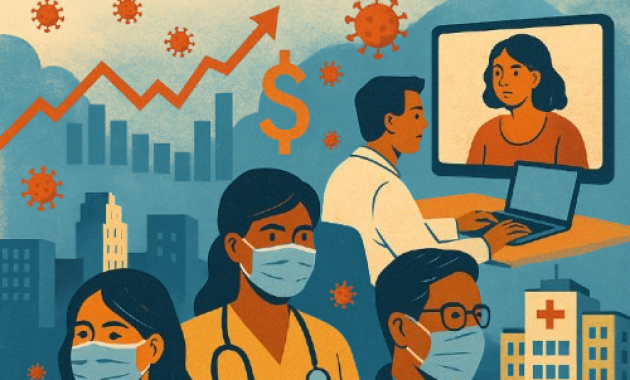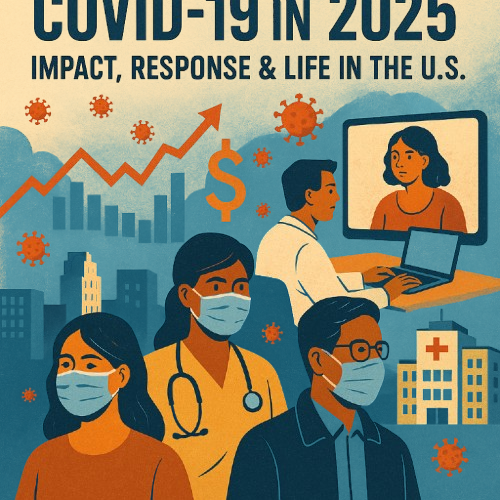Still, nobody can deny that during the fifth year of the pandemic, the world, including the United States, has entered a new stage of personal relations with the COVID-19 virus not its eradication but adaptation. Although the pandemic has passed the initial crisis phase and is much calmer, COVID-19 remains to impact the life of Americans significantly. By 2025, the virus is endemic, and new waves occur due to new variants, changing vaccination coverage, and changes in seasons. However, during this stage, the reaction of the country is not so urgent but rather proactive, as the country learned its lesson through the years.
Living with the Virus
By the middle of 2025, the United States records between 30,000 and 50,000 new cases of COVID-19 per week, which is significantly lower than the case in 2020 or 2021 but still enough to make health authorities be on the lookout. It has been mutating into various sub-lines of Omicron and the most recent of them, as scientists call it Omicron Pi-3, is highly contagious but less severe owing to the immunity provided by inoculation and past infections.
The CDC states that more than 80 percent of the population has got at least two doses of the vaccine and 65 percent received a booster that is the new and improved multivalent that has protection against newer strains. Annual booster is currently prescribed to the high risk population as is the flu shot. Dr. Elena Martinez, the epidemiologist of John Hopkins University, observes, “We no longer have mass emergency vaccinations, but targeted, seasonal updates.” This is a sustainable model but not devoid of challenges.”
2025 in Public Health Measures
Although the period of national masking and lockdowns is past, the public health requirements still exist, although in the more decentralized nature. During outbreaks, local health departments may return to masking or reduce the number of people in the community meeting. In some cities such as New York City and Los Angeles, masks are still advised in indoor settings with large groups in seasonal times as winter or amid surge of variants.
Some of the places where social distancing has become internalized are in the healthcare facilities, in senior care facilities and within transportation facilities. The need to prevent patient visits to hospitals attributed to lockdowns brought about telehealth, which is currently part of most primary care practices, with fewer demands on hospitals and an ability to offer potentially safer and more flexible care.
They are ongoing through vaccination campaigns especially in underserved and rural communities where vaccine hesitancy is still common. Community leaders and influencers are collaborators of federal efforts, like the Health Equity for Immunity Program, to raise vaccine literacy awareness and access to the vaccine. Even with this, certain groups seem to refute. According to a recent poll conducted by the Pew Research, 17 percent of adult Americans simply distrust the revised vaccinations, frequently on the grounds of suspicion of pharmaceutical corporations or regarding side effects.

Social Changes: New Normal
The Long shadow of COVID-19 has remodeled almost all aspects of the American lifestyle, and it is coming along with irreversible shifts in the modes of working, studying, and communication.
Work Culture: The work-remote and hybrid-work models have taken root in the white-collar sector. According to a 2025 Gallup report, 41 percent of the U.S. workforce is still working in hybrid positions, where people enjoy collaborating at the office, yet they are still productive at home. Organizations have reduced office warehouses, investing money into cloud-hosting and worker healthcare initiatives.
Education: Zooming lessons in times of emergency are over, and now online learning has grown. The idea of blended learning has been adopted in schools and universities through a combination of face-to-face instructions and digital lessons. The digital divide, being an apparent problem in the early years of the pandemic, has decreased because of federal and state programs that have extended broadband coverage and provided devices to underserved learners.
Travel: The travel industry is virtually back with a bang as several aspects have changed. Airport health checks, electronic vaccine certification, and easy allowances of cancellations are the norm. Even though international travel has become more available, there is active surveillance of health-related regulations specifically at destinations. The domestic tourism market has been restored to its pre-pandemic level, and according to U.S. Travel Association, it only takes a small step, since business travel is almost not followed thanks to remote conferencing opportunities.
Daily Life: Americans have adapted to the convenience of including the awareness of hygiene in a lifestyle. Hand sanitizing devices, better ventilation in open places are order of the day along with air contamination checkers. A Chicago-based public health advisor Mary Tran says, COVID taught us the importance of clean air and personal space. That cultural change is not going away.
Economic Effect and Recovery
The financial ripple of the pandemic is still felt but, the majority of industries have remained survivable. The healthcare system remains under pressure, particularly in the wake of shortages in staff and pressure on the mental health of employees. Specifically, rural hospitals are on the edge and, therefore, requests to federal governments are consistent.
Retailing has recovered immensely and this has been spearheaded by electronic commerce and a mix retailing system which comprises of making purchases online and collection in brick and mortar outlets. Tourism, once in an extreme trough, has been recovering in new business models reflecting a focus on safety, sustainability, and trips closer to the home.
However, there are industries that have had to transform themselves radically. Take the example of restaurants: they have incorporated the concept of delivery and curbside services permanently into their model. The ability to be flexible and digitalize is commonly seen as the key to survival of small businesses that did not go under pandemic.
Ongoing Challenges
Notwithstanding, there are still some obstacles. The problem of vaccine wearyness is rising particularly as the boosters become an annual consequence. Healthy younger people are now not taking the recommended doses and the result may lead to vulnerability in the future particularly when a more virulent strain appears.
The other problem is healthcare burnout. The crisis highlighted severe vulnerabilities in the U.S. healthcare system, including funding shortages; workforce shortage and resilience; and supply chain weakness, among others. Some of the first-line workers have given up the career altogether, due to the effects of trauma and burnout. The areas of investments are discussed as workforce development, mental health services, and AI-based healthcare solutions; however, their use is not consistent.
Lastly, misinformation has persistently made communication of public health problematic. The social media is a ground zero in any war of words on vaccination, treatment, and government action. The attempts of technology platforms to go through fact-checking content and boost the correct information have been successful, yet the disinformation networks still exist.
What Next? What I Learnt
The COVID-19 epidemic has become a national wake-up call, making drastic changes in the way U.S. addresses public health. What I learnt: Among the most valuable things:
Planning can save life: Medical provisions are hoarded, new testing equipment is invested in, and early-warning systems are reinforced and became federal priorities.
Health equity is essential: Inequities to healthcare access increased the impact of the pandemic on the marginalized communities. The gaps are currently an interest of policy.
International cooperation is critical: America now has a stronger presence in the international distribution of vaccines and observation of the pandemic because viruses do not care about national boundaries.
As Dr. Anthony Rivers, a former NIH public health consultant puts it succinctly, COVID-19 was an experimental opportunity in the fire. Nevertheless, it made us question what caring about each other socially, medically, and economically are. By clinging to them we will be more equipped to face the next crisis.”
Conclusion
At some point in 2025, the COVID-19 crisis is not consuming the US anymore, it is a background phenomenon shaping the American way of life. The country is no longer in crisis but is becoming practical, crisis-driven to resilience driven. Despite the existing difficulties, the shared experience has led to innovations and changes in a wide range of sectors, which proves the necessity to be united, flexible, and humane in response to threats to the health of the population.
When the United States looks forward, the phenomenon of COVID-19 will be not only the memory of vulnerability, but also its strength.
